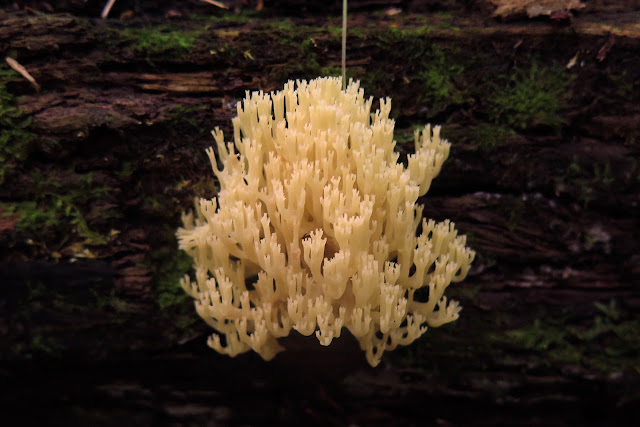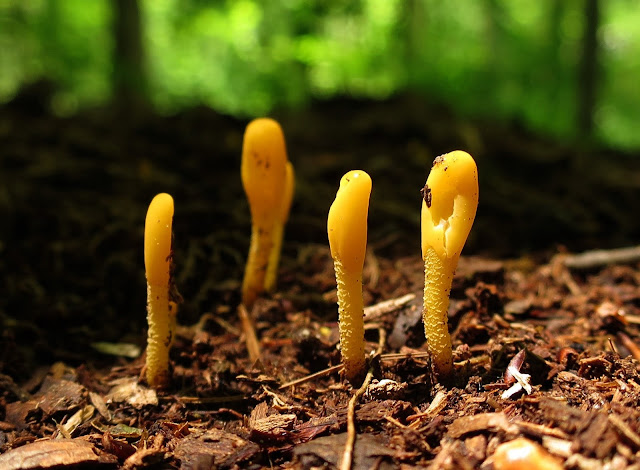Oh boy, did it rain! So much rain fell in the northeast this past week, roads were destroyed, streets and houses flooded, and sadly, some people drowned, whisked away by raging torrents. Lucky for those of us who live in Saratoga County, we did not suffer the kind of damage that visited other places in New York's Adirondack region and in Vermont. What the rain did to us was awaken every mushroom that had a spore waiting to fruit in our nearby forests. And now my camera is full of their photos and I need to clear my memory card. For two weeks, starting July 17, I'll be traveling with my son's family in the Caribbean Island of St. Lucia, my daughter-in-law's birthplace, and I will probably not be spending much time on the internet. But I do hope to take lots of photos. So I am clearing my camera with this post, and simply to save time, I'm focusing only on fungi. Just a selection, though (oh my, there were so many!), and I'm not necessarily putting official names to them. Too many fungi are difficult to pin down as to species, so just come along and enjoy some of the marvelous shapes and colors of this selection, presented alphabetically.
Amanita button
I know it's an Amanita because of the veil remnants on the cap and the basal cup. But there are several Amanitas that are colored yellow and I don't know how to tell them apart.
Bark-ringing mystery mushroom emerging from Brown Bulbous stipes
This piece of bark was completely ringed by these tiny mushrooms with the most unusual button forms. Note all the tiny brown, white-tipped bulbous tubes that circle the bark. It appears that those white tips are the caps of the whitish mushrooms that will top the brown tubes. This mushroom, when crushed, also smelled like raw onion. To take this photo, the penny was added to indicate size, and the little green inchworm just happened to come by and was added to the scene to amplify the interest. On a Facebook site, several folks have suggested species, and so far, the most likely candidate seems to be Marasmiellus praeacutus, a species that does have brown bulbous stipes, although no mention was made about an oniony smell for that species.
Here's a look at the gills of this tiny mushroom (one of the hundreds of various species fruiting now on the rain-soaked forest floor), as well as a closer look at those furry brown stalks.
Black Jelly Drops (Bulgaria inquinans)
The first time we found this species, it looked like those crusty brown cups filled with hard black stuff. A week later, we found these more mature specimens that were totally black and soft like leather. I'm sure this mature appearance must have suggested that Black Jelly Drops name, even though they were more leathery than gelatinous.
Chanterelle (Cantherellus cibarius)
One of the best edible mushrooms of the forest floor. But only when found much fresher than these raggedy ones. Some forest critters must also find them delicious!
Coral Fungus
There are a number of tan coral fungi that grow in our woods, but it would take me more time than I have right now to parse out which one this is. It's a pretty one.
Dead Man's Fingers Group
There are several fungi that go by the vernacular name Dead Man's Fingers, most of them in the genus Xylaria, and they sure can look like bony fingers sticking up from the grave. The ones in the above photo are typical, and I have no idea what the next two fungi are, except that they shared certain characteristics of the classic DMFs, whether they are related or not. They are all very stiff, not soft and spongy like many mushrooms.
This one reminded me of budding antlers, covered in velvet.
And this one made me think that this man is certainly NOT dead! (Blush!)
Dye-maker's Polypore (Phaeolus schweinitzii)
This hard flat-topped fungus appears to grow out of the ground, but like many other polypores, it is most likely growing from wood, in this case a tree root. As its common name suggests, the Dye-maker's Polypore is a natural source of green, yellow, gold, or brown dye, depending on the material dyed and the mordant used.
A peek underneath reveals its porous fertile surface, as well as some liquid drops, caused by the fungus expelling superfluous moisture. No surprise, considering how much rain has saturated the forest floor this week.
Fairy Stools (Coltricia cinnamomea)
I love the common name of these small pretty cinnamon-hued mushrooms, although since many are funnel-shaped instead of flat across the top, I fear the fairies' bottoms would more likely sink into them instead of perching atop them.
Green-colored Russula
Because of its dense white flesh and solid white stalk, I'm pretty sure this is a Russula species, but which green one is it? There are two green ones in my guides, R. olivacea and R. aeruginea, but the info provided did not help me ID this one, especially since this one is immature. I just enjoyed its color. How often do we find a green mushroom, anyway?
Jelly Dots (Helicogloea compressa)
This fungus has no common name. I just made up that name, Jelly Dots, myself. When I try to learn more about these tiny blobs of white jelly, I only get more confused. Some Google sites refer to this fungus as "anamorphic," which has to do with their "asexual reproductive stage" but I have yet to understand what that is. Ah well, at least I do know that this is a fungus and not some forest critter's gelatinous eggs. Nor is it a slime mold
Here's a photo of the rotting wood the Jelly Dots were growing on, and there's some slime mold there, too. The snowy-white stuff growing around the edges of the wood is a slime mold called Ceratiomyxa fruticosa. If you want to know how fungi and slime molds differ, a quick Google search will explain it all to you.
More Tiny Mushrooms
There were hundreds -- nay, thousands -- of tiny mushrooms all over the forest floor this week, and I have no idea what their species may be, since most lack some truly distinctive features that set them apart from all others. These two species, the tiny brown ones above and the masses of tiny white ones below, are examples of such. And frankly, I was growing weary of the struggle to put names to all the many fungi fruiting now. It was enough for me that the tiny brown ones were so cute, and that the masses of white ones were so very crowded.
Orange Earth Tongue (Microglossum rufum)
At least this mushroom is easy to ID, even though it is also quite small. The flattened head atop a scaly stem is fairly unique, especially when combined with its bright color.
Orange Needle-sharp Fungus
Nothing in my mushroom guides comes close! Not Spindle Coral nor Fairy Threads nor any in the Ramariopsis genus looks like this single sharp-pointed slender orange fungus that looks as if it were glued to the wood with some kind of white stuff. The mystery remains unsolved.
UPDATE: Thanks to a comment from my friend Sue Pierce, I looked again in my guides and on line at the jelly fungus called Calocera cornea, and yes, Sue's suggestion is quite probably correct. I had passed that name by because all of the illustrations of that species I could find showed it as "tuning-fork" shaped, while these growths were needle like. Perhaps these "needles" will later branch a bit. The clincher in one guide (Baroni's) was the mention of Calocera cornea as growing "typically with a white fuzzy base." But this was certainly a lesson in how difficult it is to determine a species of just about anything from a single photo. Thanks for the suggestion, Sue!
Puffball, Species Unknown
At least, I
think these are puffballs. They resembled Gemmed Puffballs, except the "gems" were brown and not white. They reminded me a little of coconut macaroons. I need a more comprehensive mushroom guide. No species in my several ones looks just like this. That's what makes fungus ID so hard. Each species looks quite different at different stages of maturity.
Vermilion Wax Cap (Hygrocybe miniata)
These brilliantly colored mushrooms were EVERYwhere! For sure, they could not be overlooked, shouting "HERE I AM!" even when as tiny as the head of a pin or attempting to hide among the greenery.
Two Slime MoldsOK, I know that slime molds are NOT fungi. They're not even in the same kingdom, since they demonstrate both animal-like and fungal behavior at times. But they are often included in mushroom guides, and when they are in their spore-producing stage, they even look like fungi. Sort of. But then, what do
fungi look like, but dozens and dozens and dozens of different shapes and colors and sizes? I saw several more species of slime molds this past week, but these two were the most photogenic.
Chocolate Tube Slime (Stemonitus splendens)
The spore tubes of Chocolate Tube Slime are held aloft on very fine stalks that hardly look sturdy enough to support all those cocoa-colored tubes.
Wolf's Milk (Lycogala epidendrum)
These salmon-pink pebbly-surfaced orbs could easily be mistaken for fungal puffballs, unless you squeeze one and release its same-color pasty contents. And then you understand how it got a second common name, that of Toothpaste Slime. I don't know what might have suggested the "Wolf's Milk" vernacular name, unless one could imagine these rosy orbs resembled a wolf-mother's teats.























6 comments:
They are so surprisingly lovely! I hope you have a wonderful trip and eagerly await your photos!
Have a good trip.
Fantastic!!
Thanks for posting!
For those tiny pointy yellow fingers - try p 517 of Baroni book, Calocera cornea, they are young versions; p 103 george barron book shows it too --it is a Jelly fungus.
oh and.... Bon Voyage!
I know you will have a lovely time and as wonderful as it is around here, a change of scenery is quite the tonic -Sue
Wow, what an interesting bunch of tiny fungi! Have a great trip!
All this rain is good for some. Perhaps there will be a nice harvest of Black Trumpets to come later.
I'm sure St. Lucia will provide plenty of exciting flowers and hopefully orchids for your pleasure. Looking forward to your return.
Post a Comment